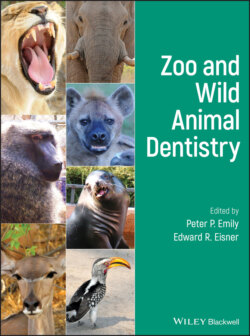Читать книгу Zoo and Wild Animal Dentistry - Группа авторов - Страница 20
Dental Evolution
ОглавлениеThe two major theories of evolution of prehistoric reptilian homodont dentition to multi‐cusped teeth were the Concrescence Theory and the Differentiation Theory as discussed by Owen (Owen 1845). The Concrescence Theory states that multi‐cusped mammalian molars are formed by fusion of a number of simple conical teeth. Support for this theory came from multi‐tuberculates in which molars had distinct cusps. It was assumed that each cusp represented a reptilian tooth, as later multi‐tuberculates had more cusps than older species. The Cope–Osborn Differentiation Theory stated that the most complex mammalian molar originated from a single‐cusped reptile tooth with formation of cusps in front and behind the original. This led to the additional cusps changing position relative to the main cusp in order to form a triangle. A heel is added by evolutionary differentiation to the triangle in the lower molar, such as the lower carnassial first molar.
One significant characteristic of the ancient carnivores is the size of the carnassial teeth in relation to their diets. In general, most carnivore dentition has changed little when compared with herbivores. Charles Darwin (1809–1882) initiated much controversy concerning evolution, including that of teeth. Darwin's early writing was a text entitled “Zoonomia,” in which was presented the theory of inheritance by acquired characteristics. Though Zoonomia was based more on speculation than science. His fossil records of the horse are one of the classic fossil records showing evolution of teeth. Darwin's “The Origin of Species” was a monumental look at the evolution of species through natural selection. The documentation of the evolution of teeth grew immeasurably in the nineteenth century. It was profoundly influenced by the Cell Theory, with J. Muller and Oskar Hertwig provoking thought.
The most extensive research and publication of the morphology and evolution of teeth was produced by Richard Owen in 1856. He classified over 13,000 specimens at the British Museum. His publication dealt a great deal with teeth, evolution and hereditary changes. Owen was most remembered for his disputed belief in Darwin's theory of evolution and his coining of the word “dinosaur.” Owen's two volumes, entitled “Odontology,” published in 1840–1845 became an invaluable research tool for more than 150 years. Frank Colyer's, “Variation and Diseases of the Teeth of Animals” in 1936 is one of the most complete treatises of Odontology.
